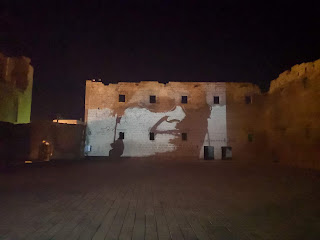Curator's Cut (Gülgün):
Time is now tight, the Open Door Festival opens on Saturday and we are getting closer to the technical 'rehearsal' night on Friday. This is pushing the artists to commit and finalize their work and the location of the projections. As a result, the pace of production has picked up and so has the stress level of participants. Our focus has been on refining concepts, testing and marrying the space and its context with the artwork. How does the meaning change when projected on a tree versus a wall? Is the space overwhelming the artwork, does the meaning get lost when presented in a public square versus a side street. Lots of questions and the answers and decisions need to be explored and made practically.
Dicle & Aliki's images processing the idea above and working with the actual space below.
The issues to consider with the location of the work are the relationship between the materials of the piece and the materiality/history/context of the square. The artist's original location choice, inside the arches of the main square was not available, now they test an alternative location. How does the marriage of the everyday, intimate feminine objects associated with female labor and maintenance work in a formal public space?
(Vasilis Vasiliou's test image on the Venetian palace walls)
Vasilis, finalized his location in the ruins of the Venetian Palace wall. This 16th century palace, the original residence of the Venetian Governor, was known as the Palazzo del Provveditore. The art piece draws on the architectural history left behind by each period of colonial rule on Cyprus: The Byzantine Period (AD 324-1191), Early Frankish (1191-1192), Lusignan (1192-1489), Genoese (1373-1464), Venetian (1489-1571), Ottoman (1571-1878) and British (1878-1960). Each period is represented by a combination of architectural remnants and coat of arms, a reminder of Cyprus' complex, multi-layered, multi-cultural past and present.
(Adi's test image on the Venetian Palace walls)
Olgu's concept involves animating the legends and stories of Famagusta. These stories are urban myths based on historic events, ghost stories and tales told by mothers to scare their children. Olgu who is from Famagusta, combines these remembered fairy tales into surrealist video collage.
(Olgu's test image)










No comments:
Post a Comment